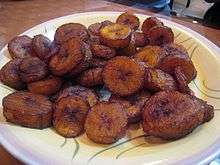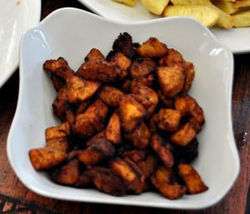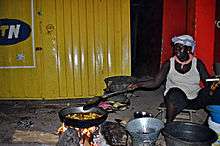Fried plantain
Plantain, believed to have originated in southeast Asia refers to the cooking banana, cultivars of the banana plant, which produces an edible fruit that is full of starch and rarely eaten raw. Though similar in appearance, the two banana varieties are typically used in very different ways. Usually, in many cultures where this fruit is a staple diet, it is boiled, fried, or cooked while green due to the starch levels. In some African regions, the plantain can be reduced to flour or for beer-making. However, in many instances an encounter with plantains is usually in fried form.

Fried plantain is a dish cooked wherever plantains grow, from West Africa to East Africa as well as Central and South America and the Caribbean countries like Haiti to Cuba and in many parts of Southeast Asia, where fried snacks are widely popular. In Indonesia it is called gorengan. It is called alloco in Côte d'Ivoire and dodo in Western Nigeria otherwise known as simply fried plantain in other parts of Nigeria. Kelewele is a fried spicy plantain or can be fried as a side dish for Red Red (African stewed black-eyed peas) and fish stew in Ghana.[1]
Fried plantain is also eaten in some countries in South America or the Caribbean where African influence is present. For example, in the Dominican Republic, Cuba and Puerto Rico, it is common to cut plantains in slices, fry them until they are yellow, smash them between two plates and fry them again. This is also a common dish in Haiti, referred to as "bannann peze", and throughout Central America, referred to as patacones in Costa Rica, Panama, Colombia and Ecuador, and as tostones in Guatemala, Nicaragua, and Puerto Rico. In Honduras and Venezuela they are referred to as "tajadas".
Consumption and uses
Fried plantain may be served as a snack, a starter or as a side dish to the main course, such as with Jollof rice, spicy barbecued meat, tomato stew or beans. It is made in different ways: salted or unsalted, cut into "ears", "fingers", can be diced, or fried whole.
Fried yellow plantains are sweet bananas from Central America and the Caribbean fried in hot oil. They are sometimes eaten with sour cream, ketchup, or a mayonnaise-ketchup mixture.
Alloco

Alloco, as it is called in Côte d'Ivoire and Burkina Faso. It is a popular West African snack made from fried plantain. It is often served with chili pepper and onions. In Nigeria, it often serves as a side or can be consumed by itself.
Alloco is widely considered as fast-food and is sold on the streets of Côte d'Ivoire. An area with many grilled meat and alloco food vendors in the Cocody neighborhood is named Allocodrome, after this dish.
Kelewele
 | |
| Type | Snack |
|---|---|
| Place of origin | Ghana |
| Main ingredients | Plantains, spices |
Kelewele is a popular Ghanaian food made of fried plantains seasoned with spices.[2] In English, it is sometimes referred to as hot plantain crisps.[3] In Accra, kelewele is usually sold at night by street vendors and sometimes in the afternoon by the country side women.[4][5][6] It can be served with beans stew, peanuts,[6] or alone as a dessert.[7] Kelewele is also a popular choice for dinner.[8]
Originally from Ghana, kelewele has been popularized in America by several recipe books (recipezaar, 2009)
Preparation
The plantains are peeled and may be cut into chunks or cubes.[6] Ginger, cayenne pepper, and salt are the typical spices used to make kelewele.[4][6][9] Onions, anise, cloves, nutmeg, cinnamon, and chili powder, however, may also be used as spices.[4] Commercial preparations exist that can simplify preparation and offer a standardized taste.[10] For example, the oil should be hot and the plantain should not be too soft or it will absorb too much oil.[11] The plantain should be fried until the sugar in it caramelizes, and produces brown edges on the plantain.[9][11]

 Plantains being fried
Plantains being fried- A platter of fried plantains
See also
- Tostones
- Chifle
- Banana chip
- Pisang goreng
- Vegetable chips
- List of African dishes
- Cuisine of Ghana
References
| Wikimedia Commons has media related to Fried plantain. |
- Isoun, H.O. Anthonio, M. (1983). Nigerian cookbook (Repr. ed.). London: Macmillan. ISBN 0333326989.
- Elizabeth Harris (1976). Ghana: a travel guide : supplementary notes on Togo. Aburi Press. Retrieved 14 June 2011.
- "Ghana, Food & Drinks, Kelewele". Retrieved 14 June 2011.
- "Kelewele - The Congo Cookbook (African recipes) www.congocookbook.com -". Archived from the original on 23 September 2015. Retrieved 14 June 2011.
- Jessica Kuper (January 1997). The Anthropologists' Cookbook. Kegan Paul International. ISBN 978-0-7103-0531-2. Retrieved 14 June 2011.
- Osseo-Asare, Fran (2002). ""We Eat First With Our Eyes": On Ghanaian Cuisine". Gastronomica: The Journal of Food and Culture. University of California Press. 2 (1): 49–57. doi:10.1525/gfc.2002.2.1.49. JSTOR 10.
- "Ghanaian Recipes" (PDF). Archived from the original (PDF) on 25 March 2012. Retrieved 14 June 2011.
- Angela Shelf Medearis (14 September 2004). The ethnic vegetarian: traditional and modern recipes from Africa, America, and the Caribbean. Rodale. p. 7. ISBN 978-1-57954-618-2. Retrieved 14 June 2011.
- J. Maud Kordylas (6 February 1990). Processing and preservation of tropical and subtropical foods. Macmillan. p. 84. ISBN 978-0-333-46845-6. Retrieved 14 June 2011.
- "ANIS Spices Facebook Page". Retrieved 9 October 2014.
- Lydia Polgreen (February 1, 2006). "A Taste of Ghana". New York Times. Retrieved 2008-08-05.
Further reading
- "Fried plantain". Nigerian Food Recipes. 2019-05-18. Retrieved 2019-06-04.
- "Fried plantain". Encyclopedia Britannica. 2019-09-09. Retrieved 2019-09-20.
- http://www.raw-food-health.net/Plantains.html